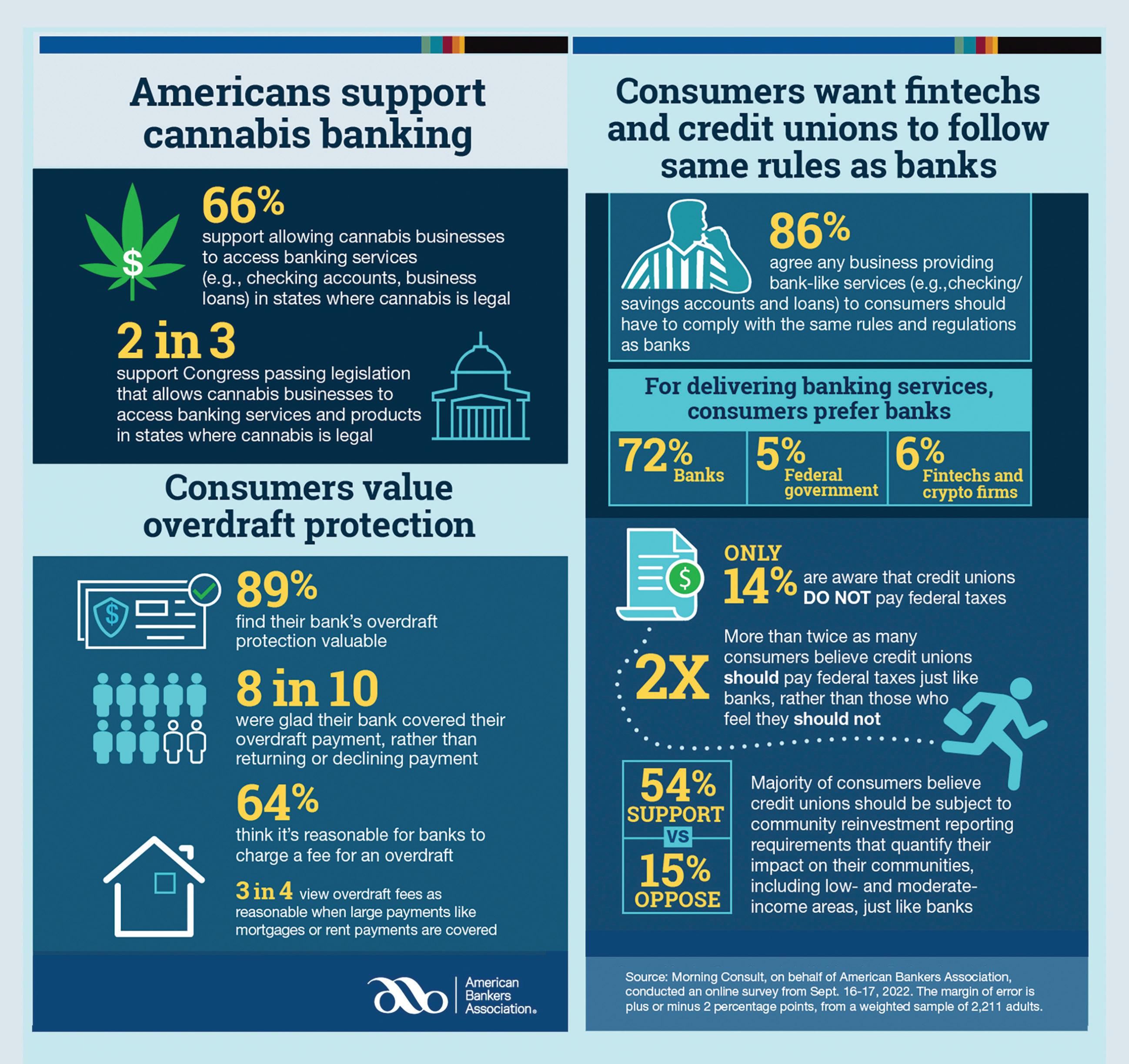













The curriculum consists of practical classroom ses sions and experience with a computer-generated bank simulation. Through this hands-on practical training, bankers will gain: an increased under standing and appreciation of all functions within the bank, allowing participants to contribute more effectively to their bank; an understanding of bank ing’s role in the financial services industry; and, the opportunity to expand skills and knowledge beyond on-the-job training as preparation for additional responsibilities.
Questions: Paula Cross, pcross@kybanks.com
of the
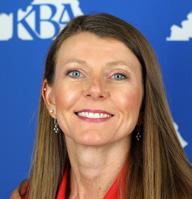

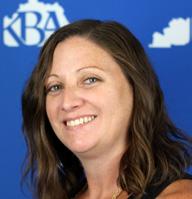

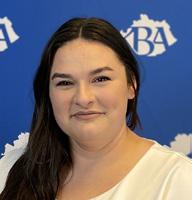

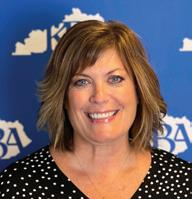



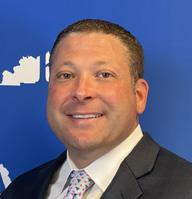
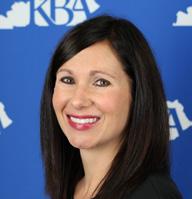
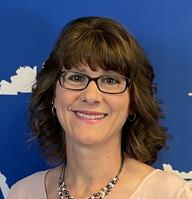

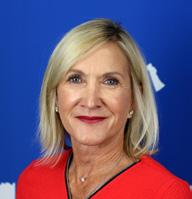
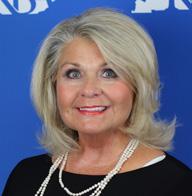
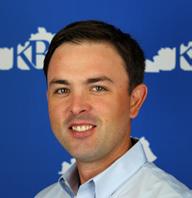


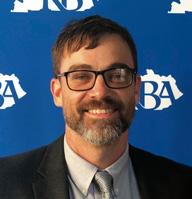
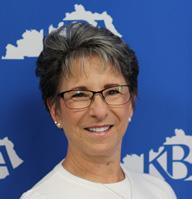
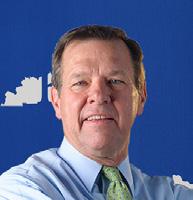

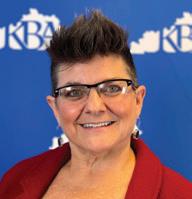




Represents Group 1 Jeff McDaniels,
Farmers Bank
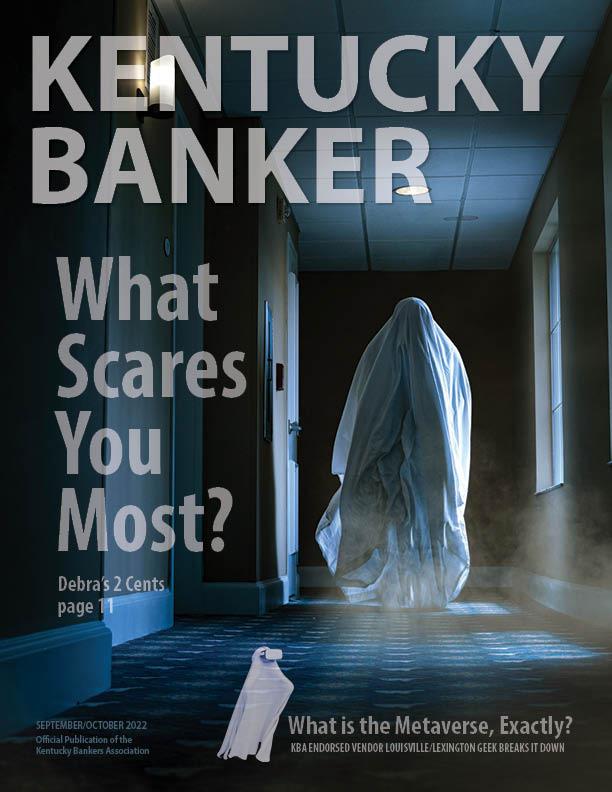

Represents Group 2 Michael W.
The Sacramento Deposit
Represents Group
Greg Pawley, President

The Cecilian Bank
Represents Group
Bank

Represents Group
Jennings,
First
Represents Group
Represents Group
Represents Group

Represents
Represents

 Ruth O’Bryan Bale Chairman, South Central Bank
Ruth O’Bryan Bale Chairman, South Central Bank
Becoming a member of the Kentucky Family of Commu nity Bankers has grown into a great privilege and honor for me. I didn’t get my feet wet, in banking, early in life. As a matter of fact my family didn’t initially invest in banking until 1972, when I was 21 years old.

I am the second of seven children born into an entrepre neurial family. As I was growing up, my family invested in everything from drive-in theaters, to full-service gasoline, to tobacco warehousing and auctions. That spirit of entre preneurship was an integral part of my rearing and dinner table discussions. Business for my family was also always intertwined with service to community, along with develop ing and preserving relationships.
We were reared in small-town South-Central Kentucky, where our heritage and roots are deep. We lived in South ern Hart County, in Horse Cave, where our parent’s home remains in family ownership and occupation.
After graduation from Caverna High School, my interests and involvements shifted to Bowling Green, Kentucky, as I enrolled in Western Kentucky University and completed my studies there. Moreover, Bowling Green remains my home to this day.
Beginning in my late teens and continuing until 2003, man agement of family-owned hotels was my career and my calling. Then in 2003 the dynamics of our family business es made a drastic shift, with the passing of our father. I en tered bank management, having previously never wet my feet and I’ve been drinking from a bank management fire hose ever since.
We have chosen the Community Bank Model for our banks, and it has been a part of our legacy to preserve. I realize as a banker and as a manager, a more efficient model might produce more ease in management for our family. I also re alize that more efficient models will leave little room for our community investors, who have contributed much to the success of our bank. Our banks now serve 18 independent
communities. It takes a lot more effort, but we like to make independent decisions that are tailored to each of those communities we serve.
Our banking decisions and our management style is based in personal relationships. We believe that investment in our employees and their talents will provide the best results for our valued customers. We then believe that strong customer experiences will provide the best results for us.
I truly look forward to sharing a strong relationship culture, as I serve as Chairwoman for the Kentucky Bankers As sociation. I hope to share my message, of generosity, per sistence, and community service, as it has been shared with me during my years in management. “When the tide rises, all the ships float higher.”
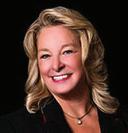
When the tide rises, all the ships float higher.
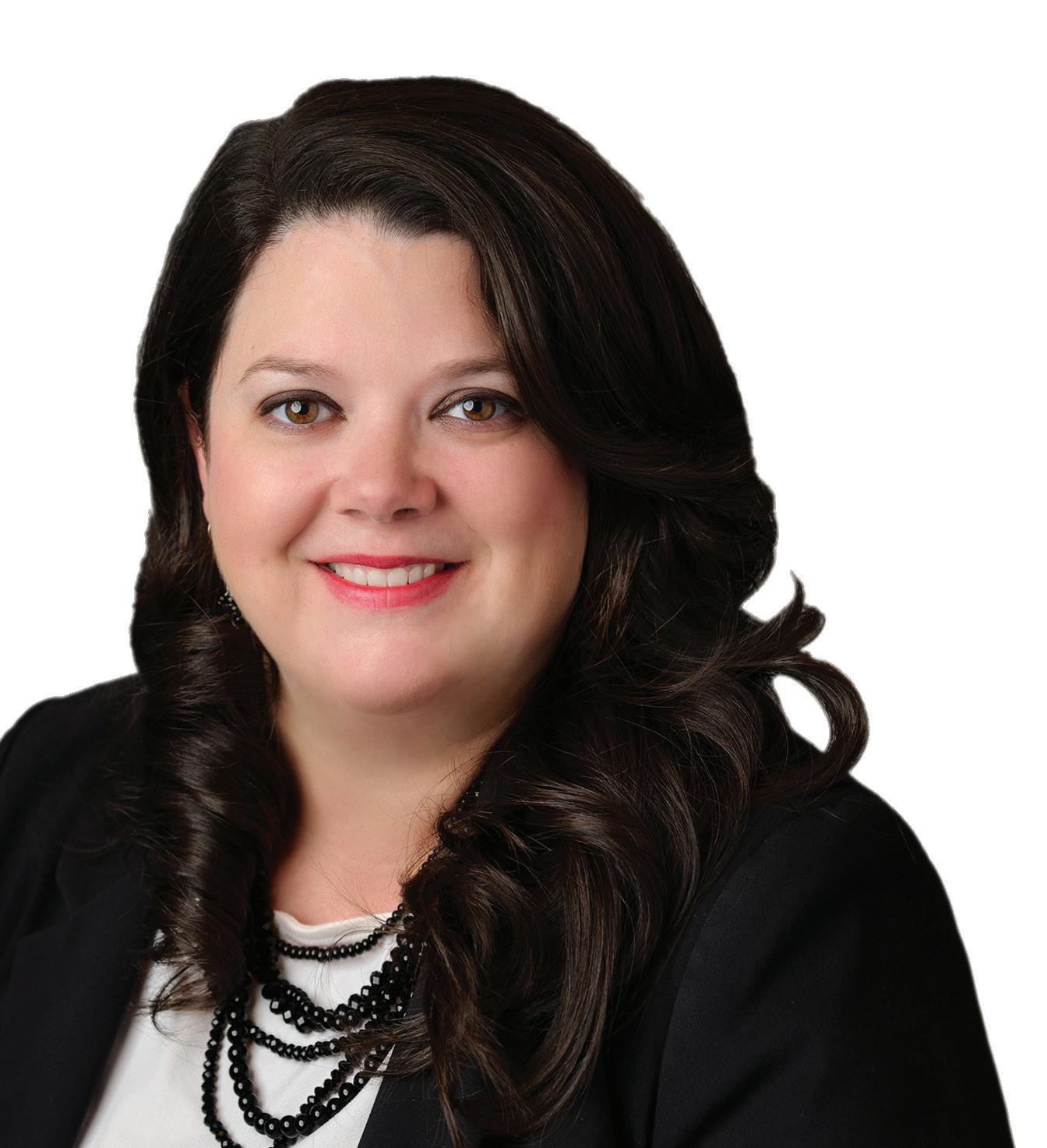

In the year between the 2021 and the 2022 Annual KBA Conventions, our members, and their families, friends and neighbors, experienced two once-in-a-generation weather events: the December 2021 Tornado in West ern Kentucky and the July 2022 Flooding in Eastern Kentucky. Each disaster devastated entire buildings, neighborhoods and communities.
But it did not deter the spirit of Kentucky, nor the banks and bankers who serve their communities in good times and in bad. It is in our industry’s DNA to go the extra mile. Over the years I’ve witnessed Kentucky’s banks repeat edly respond to their community’s needs, for customers and causes large and small, but never has it been so apparently on display as it was in the last year. That’s why “The Extra Mile” became the theme for this year’s Convention. It’s what we do.
In the wake of both disasters, we had banks, and individual bankers, through out the state and nation, from those who weren’t directly affected by the storms, donate to our Kentucky Bankers Relief Fund. In that year we have collected over $1M in donations. Other state bank associations, the ABA, CSI, Associate members and Endorsed Vendors, many of which were with us at Convention, also shared their generosity with thousands of dollars in donations.
ABOUT OUR VENDORS: Please take a moment to look through the list of sponsors and exhibitors on kbaconvention.com. We couldn’t put the Con vention on that we do without their support. Please consider one of these companies first when you’re shopping around services. Most of you already use our Endorsed Vendors of the KBA and we couldn’t be more grateful for your support.
NOTE: You can go to the KBA’s YouTube channel to watch a video about the Kentucky Banker Relief Fund disaster efforts: kybanks.com/video

The General Session speakers were once again, world class. They covered a wide range of topics: from economic outlooks, political reports, data risk, bitcoin and employee turnover. Our very first speaker, Dr. Thomas Hoenig, a Distinguished Senior Fellow at the Mercatus Center at George Mason Uni versity, brought his experience and insight to the topic of the current state of the economy - we didn’t waste any time getting to the economy!
One of the great things about how our sessions are organized is that we get to talk to the presenters after they give their remarks. We get to get to ask them some questions after they speak. Joining me on the stage to interview the speakers this year were John McGarvey (our perennial emcee), and our 2021-2022 Chairman, Ja Hillebrand.
We had a very special guest join us in Marco Island for our second speaker. U.S. Representative Andy Barr took to the podium after a short video was played to the audience with clips from a pair of appearances he had over the summer. This past July, Barr gave an impassioned rebuke of H.R. 4277, the Overdraft Protection Act. His remarks advocated for Kentucky’s Community Banks in the strongest possible terms, and against the Act, which he said would be “a killer for community banks and their small-town customers.” This past August, on Meet the Press, Rep. Barr said: “These seats belong to the American people, and there is a massive disconnect between the priorities of the politicians in Washington and the concerns of the American people.” I am never not impressed when Rep. Barr shares with our members his Wash ington insight. It is important to have friends of community banking in DC, and we can definitely put Rep. Barr in that group.
Some new faces rounded out the rest of the program. Alyson Van Hooser is a Kentucky-native with deep roots in banking. She told an inspiring story of how she faced adversity in her life and overcame it to be a mother of four and
leadership author. Dr. Lindsey Piegza, Chief Economist for Stifel Financial, a regular guest on CNBC, CNN and Fox Business, presented her concerns about the economy, and a little optimism with all of us. Dr. Laura Barthel, Assistant Professor of Accounting and Corporate Entrepreneurship in the College of Business at EKU, brought the persistent challenge of employee recruitment and retention, and told us about the tailored curriculum EKU has for prospective banker recruits.
We’ve seen Milton Bartley, with ImageQuest, before on the Convention stage. He learned about life from serving as a combat leader in the United States Army where “it takes a team of committed individuals to build and grow a business in today’s world of rapidly changing technology.” People paid a lot of attention to Milton this year, the technological pace we are on is going to only get faster, so his approach and expertise helped a lot of us who might be technologically overwhelmed.
Rapidly changing technology, in a rapidly changing geo-political map, with alliances being made and unmade, were topics that helped set the stage for the Former CIA Chief of Soviet Operations, James Olson. Awarded both the Intelligence Medal of Merit and the Distinguished Career Intelligence Med al, he painted a bleak and terrible picture of Vladimir Putin and the war in Ukraine. It was a sobering reminder about the state of things in the world today outside of Kentucky. It reminded me that world history is becoming more relevant today than ever before in my life time. It seems many of our leaders either never learned about it in school (which in today’s education system is a very high likelihood) or they have forgotten it and we are moving toward repeating it at warp speed.
Former U.S. Congressman, Jason Chaffetz, wrapped up the Annual Banquet with a presentation on The American Spirit. A fitting end to a stellar array of expert speakers and industry insiders. For all of you who attended, you can go to the KBA Convention website and review the slide decks or presentation PDFs. Visit: kbaconvention.com
The last thing we traditionally do at the end of the second General Session is install the upcoming Board Officers. Outgoing KBA Chairman, Ja Hille brand, passed the torch to our new 2022-2023 Chairwoman, Ruth O’Bryan Bale. Ruthie became the second woman to become head of the KBA Board when she was installed at the Convention.
We have a very strong Board, and with that comes a need for strong leader ship to meet the challenges we face. Ruthie will provide that. She’ll have big shoes to fill. Ja was an exemplary Chairman, putting more hours in for the KBA than you probably know. I can’t thank him enough for what he has done for our Association during the span of his banking career, but especially in this last year. Thank you, Ja.
In addition, we took a moment to recognize Bob Ow sley for attending his 65th convention in a row. Bob has been a welcome face at every convention since 1957 and is always there with a smile and kind word for all. Bob, pictured at right, celebrated his 90th birthday on October 12, 2022. Happy Birthday Bob from all your friends in the banking community
And, thank you to everyone who was involved in making this year’s Convention so special. We re ceived rave reviews about this year’s location choice, the JW Marriott in Marco Island. Next year we’ll be at The Broadmoor Resort in Colorado Springs, so put that on your radar. Until then, keep doing what you always do – go the extra mile.

...made official at the conclusion of the 131st Annual Convention (9/20/22).
Ruthie O’Bryan Bale is Chairwoman of South Central Bank, Inc. and its holding company South Central Bancshares of Kentucky, Inc. Bale is a business veteran with more than 40 years of experience in lead ership roles in the banking and hotel industries. During her tenure as Chairwoman, South Central Bank has become a recognized leader in providing traditional banking services and unparalleled customer ser vice to communities across Kentucky. Bale earned a Bachelor of Arts degree from Western Kentucky University and is a graduate of the Hotel Administrator program and Kentucky Bankers School.
Bale is an engaged member of numerous community service orga nizations in Bowling Green, where she resides, and has served as a past board member for the Southern Kentucky Performing Arts Cen ter, Tourism and Economic Development Council, Kentucky Hotel and Motel Association, Commonwealth Health Foundation, and Past President of the Bowling Green Warren County Hotel and Motel As sociation.
“It is a tremendous honor to serve as the 2022 Chairwoman of the Kentucky Bankers Association,” said Ruthie Bale, Chairwoman of the Kentucky Bankers Association. “I look forward to leading this important organization as we continue to serve Kentucky’s banking industry.”

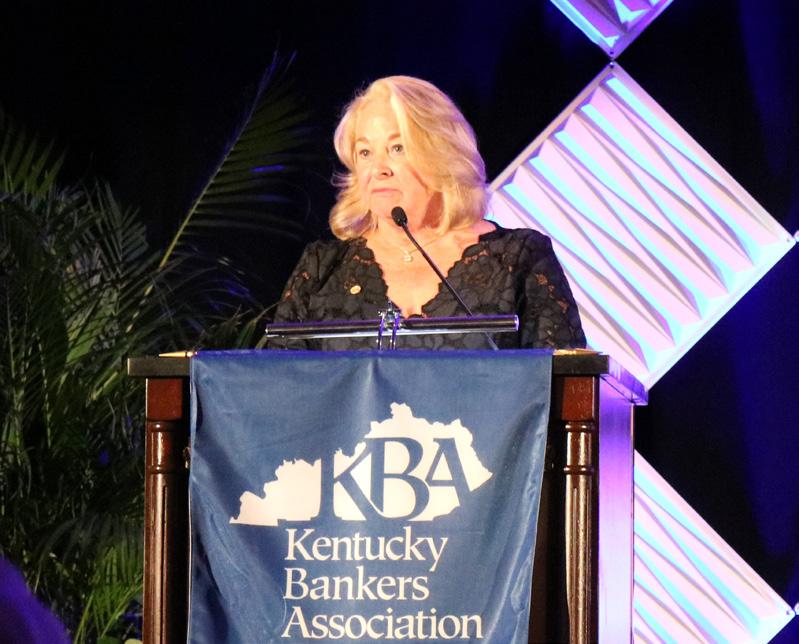
“These are some of the most challenging times our industry has ever faced. We’ll need our best “boots under the table” in the coming year,” said Ballard Cassady, President and CEO of the Kentucky Bankers Association. “We have a very strong board and with that comes a need for strong leadership to meet these challenges, and that is exactly what Ruthie will provide. Her experience has prepared her for this import ant position for our Kentucky banking industry and I look forward to working with her in service to Kentucky’s banks and Kentucky’s communities.”
Mark D. Strother is the 5th generation of his family to serve as Presi dent of The Commercial Bank of Grayson. His entire career has been spent at the bank where he has served as a Director since 2003 and as President since his father, Jack, retired in May 2014. Mark is a graduate of East Carter County High School, Vanderbilt University, and the Graduate School of Banking at the University of Wisconsin – Madison.
He has served his community in many capacities through his work with the Grayson Area Chamber of Commerce, Project Merry Christ mas of Carter County, United Way of Carter County, Grayson Rotary Club, and the Grayson Jaycees. Mark previously served as a member of the Grayson City Council; and he remains a member of the Grayson Parks and Recreation Board.
The KBA Board selected April R. Perry, Chairman & CEO, Kentucky Farmers Bank, to sit for the office of KBA Treasurer for the 20222023 year.
Bylaws of the Kentucky Bankers Association call for the election of nine members of the KBA Board of Directors by member banks in each of the Association’s nine groups for alternating three-year terms. (See the full list of Officers and Board on page 5 of this issue of Ken tucky Banker magazine.) At the Group CEO Meetings held in May, a new director from Groups 1, 4 & 5 was elected:
Group 1: Jeff McDaniels, President & CEO, Farmers Bank & Trust Company, Princeton
Group 4: Jason T. Jones, President, Morgantown Bank & Trust Company, Morgantown
Group 5: Don D. Jennings, CEO, First Federal Savings Bank of Kentucky, Frankfort
You are facing one of the scariest times in banking history.

Banks have always had to keep multiple balls in the air to ensure that every emergency gets the necessary attention. But, have we ever seen a time when so many groups seem to be out to destroy the banking industry?
That probably sounds dramatic, but it seems true to me.
The most obvious evidence of that is made apparent by the data. Every quarter, the FDIC releases its “State Tables,” which allows you to compare data between one state during specific quarters, one state against another state or a state against national data. (VISIT: state-tables.fdic.gov)
The most recent State Table data is for the quarter ending June 30, 2022. The “State” data is for banks headquartered in a particular state. The data shows that Kentucky has lost 31 Kentucky bank char ters in the last five years and 38 in the five years before that, for a total of 69 lost bank charters in the last ten years. Kentucky isn’t an anomaly. You can run the same comparison for any other state and see the same trend—in the last ten years the country has lost 2474 bank charters.
When we look at this trend, it could be caused by any number of things; or, more likely, a combination of things. Certain fintechs are entering the world of financial services without the same level of oversight that banks have to deal with. Similarly, other providers of financial services, like credit unions and the Farm Credit System, don’t have the same tax burden. And, even when competitors are regulated, it is not at the same level of scrutiny that banks feel. The SBA is considering allowing fintechs to lend under that program. This unfair competition allows them to compete primarily through speed. A recent survey I saw reported that while most small busi nesses still want to go to a bank, those numbers are changing.

That brings up customers. They want speed, free frills and no re sponsibility. The savvier customers want complete digital/phone access and fraud protection. The less savvy still wants low or no fees and ability to make mistakes without penalty; and, the CFPB seems to support them—at least for now. The one thing that banks have covered so much better than the competition is access to bank personnel, whether in person or by phone. The good news for the smallest banks is that they are still perceived as a strong pillar of the communities they serve.
But regardless of your reputation, customers have also become so accustomed to Reg E (and other regulations) and incorporated pro tections that they don’t even try to protect themselves. And, certain folks in DC are standing with them. As a result, customers and regulators do not want late fees, overdraft fees or any other fees (so called “JUNK” fees) that would make sense to a responsible consumer.
Regardless of which regulator is your primary regulator, you see each one following the same lead—often that lead is the CFPB. We have constantly predicted that the CFPB would be difficult regulator to deal with, but that has really shown to be true most recently. Sometimes even with formal regulation, regulators ap prove guidelines and use laws in ways they were never intended (and look only to NSF guidelines to see regulators implementing changes in ways that seem retroactive). All of this without any concern as to whether the consumer needs, wants or understands the service offered.
Regulators move too fast and Congress moves too slow. For ex ample, banks need to be able to legally bank cannabis business for states where it is legal. Cannabis is legalized in many states and confused by local law enforcement with legal hemp businesses. Banks are told that their regulators won’t enforce the federal pro hibition on banking cannabis, but is that true and when will it not be true again? We can’t know.
The Fed recently finalized a rule that requires debit card providers until July 2023 to ensure that ALL transactions must be able to be processed by at least two unaffiliated networks. This is a signifi cant change from the previous rule and posses a potentially signif icant burden (and cost) on issuers. The Fed assumes that this will result in cost savings that will be passed on to the consumer—do you recall the Durbin Amendment?
Regarding fintech, we see “stablecoins” being discussed in Wash ington. Stablecoins can change the entire banking system dramat ically, by allowing users to totally eliminate the need for a tradi tional bank for the purpose of making or receiving payments…all with the backing of the Government, if adopted by Congress. The bottom line…
The public and others view new digital sources as unique and in teresting. And, banks as utilities (safer and more trustworthy), but without the need for profit and that is where the problem occurs.
Happy Halloween—Maybe the New Year will be better.
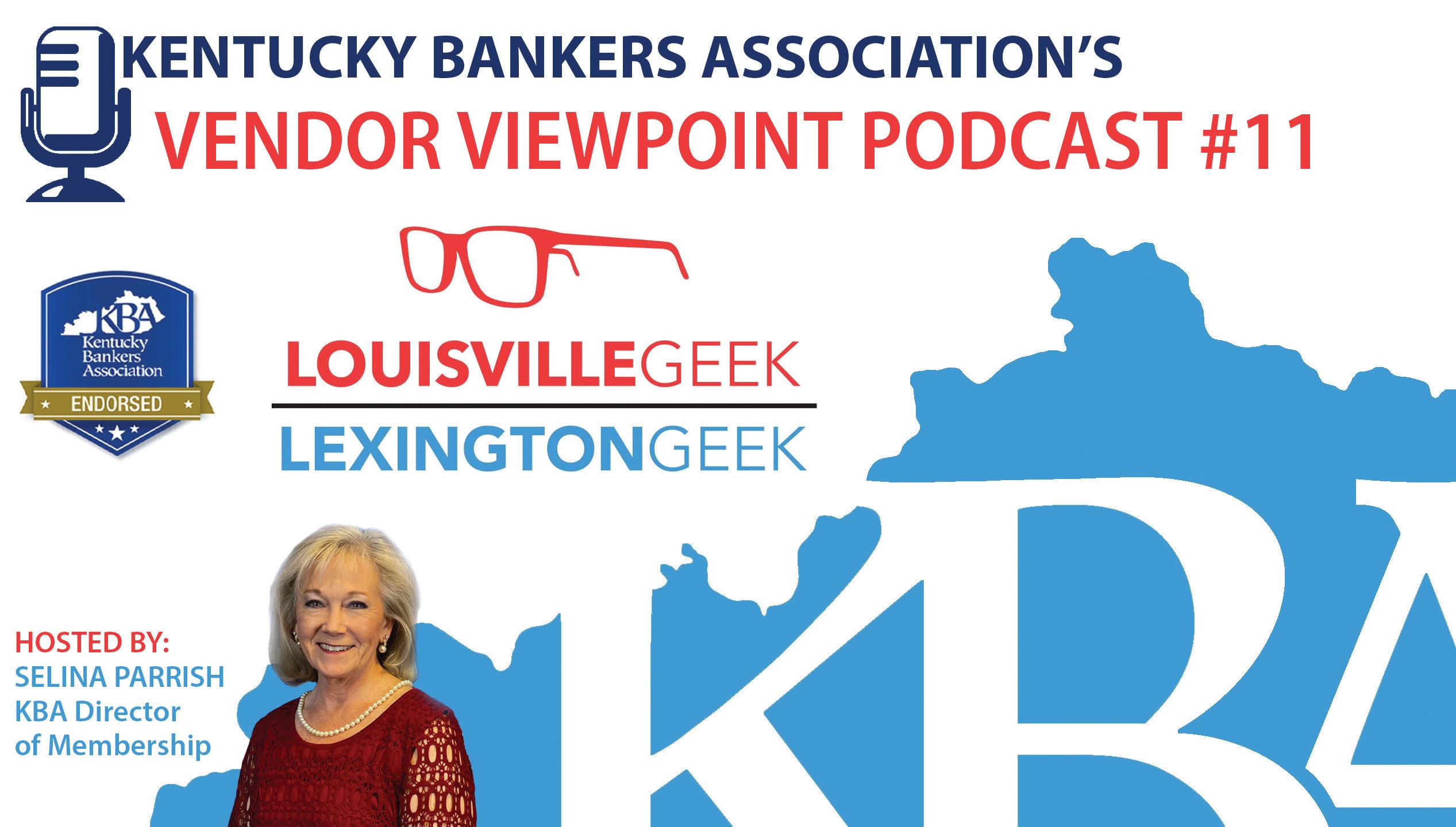 James
James
In my first “Chairman’s Corner” column a year ago, I talked about what it means to me to be a Kentucky banker. This past year, I’ve seen what it means to so many of you. It has been an honor to hold the position of KBA chairman. It allowed me to fuel my passion for giving back, forge lasting personal and professional relation ships, and visit all corners of the state to see the incredible work being done by community bankers.
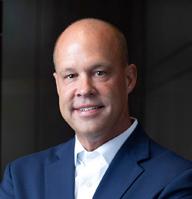
We are so blessed to have an exceptional staff at the Kentucky Bankers Association. Seeing the work they do behind the curtain brought my appreciation for this organization to a new level. I am grateful for their collaboration, tenacity and enthusiasm. I’ll miss getting down in the weeds as your chairman, working to solve problems and overcome barriers. I knew they worked their tails off for this industry but seeing it day in and day out was truly special.
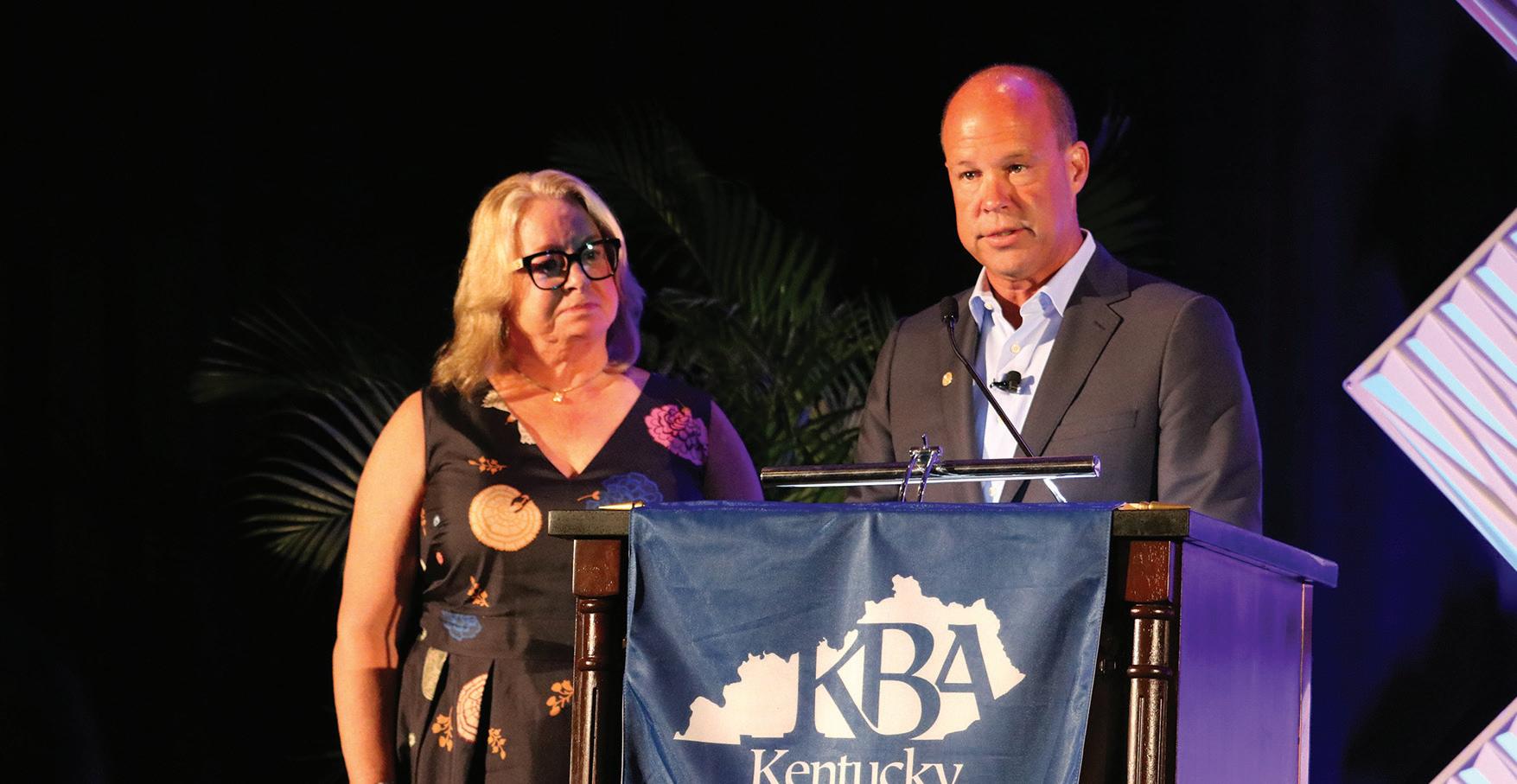
I am proud to work in an industry that understands our duty for community involvement. Disaster struck many of our friends and neighbors this year. Tornadoes and flooding and the lingering im pacts of the pandemic brought out the best in us. The response I saw from Kentucky bankers to lift each other up, sharing their time and treasures was remarkable.
Every time we needed you, you were there ready to step up to a new challenge and pay it forward. The theme of our convention was “The Extra Mile,” which seems like an understatement when I look at how far above and beyond Kentucky bankers went in 2022. The miles you logged, and the miles ahead it put our customers, have driven us all forward.
It fills my heart to have a job that aligns with my personal beliefs and be surrounded by others that share the same charitably minded belief system. I gained so many new friends as KBA chairman. Aside from an epic convention and countless events throughout the year, I got to interact with so many of you one on one to build bonds that will last for a lifetime.
Relationships are at the core of community banking, and I am thankful for the ones I’ve built this past year. Some of you I’d never met and others I’d never had the pleasure of really getting to know. Seeing your values in action and getting exposure to how you make ripple effects into your own neighborhoods is inspiring.
I look forward to growing our connections inside and outside the KBA for years to come. I’ve been active with the KBA for several years, and no longer being chairman will not change that. My dedi cation here as an ally and advocate will continue. I learn something new at every KBA event I attend and look forward to seeing you all whenever we gather for events.
This chairman post requires a deep commitment to this state and our industry. I am excited to see Ruthie Bale take this role and run with it. I’ve enjoyed getting to know more about her and her fam ily’s longstanding legacy here in Kentucky. They hold true to the community banking philosophy proudly serving Kentucky com munities.
Ruthie is an ideal fit for this position – great at building relation ships and a personality suited for the times we are in. Having Ruth ie at the helm will be beneficial as community banks continue to set themselves apart from larger competitors. She understands the service style and high quality necessary to make us successful and keep us relevant. The banking industry is in her bones. She is a shining example of a Kentucky banker and will be a fantastic lead er for our next year.
It has been a privilege to hold this role and represent you. Your passion and drive make us all better together. Thank you again and welcome, Ruthie!
Whenever there’s a complex or obscure topic I’m interested in but can’t quite make sense of, I typically turn to my favorite Reddit community “Explain Like I’m 5” for help.
If you aren’t familiar with the community, it’s basically a no judge ment zone where people can ask questions about complicated sub jects and other community members explain the answer in a way a five-year-old would understand. Popular topics might include sci ence, technology, law and economics.
One of the things I love about the community is it typically gives me a boost of self-assurance because I usually find I’m not the only idiot asking these questions. It’s similar to the feeling you experience when you Google a random question (that you should probably know the answer to) and the predictive text autofills your question before you can finish typing.
I believe the correct psychological term for this phenomenon is cognitive empathy.
Ever since the metaverse propelled into the mainstream thanks to Facebook’s rebranding as Meta late last year, I’ve tried to wrap my head around what the heck it is. Considering I work, live and breathe technology, I should be able to figure this out!
Regrettably, no matter how many podcasts I listened to or articles I read about the metaverse, I still struggle to fully comprehend it. How do I get to the metaverse? Does someone own the metaverse? Do I have to wear a clunky headset in order to enter? Do I even want to go to the metaverse?
Feeling out of the loop, I decided it was time to ask my favorite Redditors to explain the metaverse to me like I was five. If you’ve also struggled to fully grasp this topic, have no fear. While I cer tainly don’t have all the answers, and while the metaverse will con tinue evolving for years, here are a few tidbits I plan to use when my real-life five-year-old begins asking me questions.
What exactly is the metaverse?
At its most basic, the “metaverse” generally refers to a virtual world that lies beyond or is an extension of the physical world. It’s an evolution of the internet and it’s often described as online spaces where people can socialize, work and play using avatars.
Do you remember I need you to explain it like I’m five; I’m still having trouble wrapping my head around the concept?
Think of it this way: The internet is the “world wide web” and is used for a vast array of different activities, ranging from shopping and working to socializing and banking. Practically everything that exists in the real world can now be found on the internet and even tually will also be “in” the metaverse.

Because the description of the metaverse is so broad, this is a di vided topic. Some say it already exists in the digital worlds of Ro blox, Minecraft and Fortnite (which allow players to gather in 2D environments). Others claim we are still 10-15 years away from the metaverse being a reality and that the true metaverse will be built for the next generation of consumers, who will be key to maximiz ing its adoption and take up.

In short, no. The vast majority of today’s metaverse experiences can be accessed with any computer, or even a smartphone or video game console. By definition, the metaverse is any virtual space in which users interact within a computer-generated environment. In this way, virtual reality (VR) and the metaverse can combine for an enhanced experience, but it is not a requirement you have both.
However, when you enter the metaverse using VR, the experi ence feels more realistic due to the sense of immersion the headset screen delivers. The virtual world appears as if it’s really in front of you, and the controllers you hold in each hand enable interacting with objects and controlling your avatar, which furthers the immer sive experience.
The goal is that, eventually, anything you can do in the real world will have a virtual counterpart in the metaverse. However, it isn’t about replacing reality (a la the Matrix or Ready Player One), but working in sync with your real life in order to enhance it.






On September 21, 2022, the Architectural and Transportation Bar riers Compliance Board (Board) issued a proposed rule that, if ad opted, will require new Americans with Disability Act (ADA) and Architectural Barriers Act (ABA) compliance requirements for self-service transaction machines (SSTMs) across various industries, including automated teller machines (ATMs).
In issuing the proposed rule, the Board stated it is increasingly com mon for SSTMs to have touchscreens without a physical keypad or other tactile controls that pose barriers for users who are deaf or hard of hearing by failing to provide captioning and text equivalents for audible information. The Board also noted that these devices must be accessible to people with physical impairments, including those with wheelchairs and other mobility devices, have limited dexterity, or who are short of stature. Sufficient clear space at the device is neces sary to accommodate wheeled mobility aids. Controls and features must not require delicate motor movements or fine dexterity.
The proposed rule would require “Clear floor or ground space is required so that people with disabilities, including those who use wheeled mobility aids, can approach and position at ATMs or fare machines in a forward or parallel direction. This clear space gen erally must be at least 30 inches wide and at least 48 inches deep. Additional space is required for maneuvering where this clear space is obstructed on both sides for more than half the depth.”
“Operable parts for ATMs and fare machines must be located within accessible reach ranges. They must be usable with one hand, and not require tight grasping, pinching, or twisting of the wrist, or more than 5 pounds force to operate. Users must be able to differentiate each operable part by sound or touch without activation; touch activation is permitted if a key to clear or correct input is provided.”
“ATMs and fare machines must provide speech output (recorded or digitized human or synthesized) through a mechanism that is read ily available to all users, such as an industry standard connector or telephone handset. The speech function must have volume control and allow users to repeat or interrupt output. Braille instructions for initiating the speech are required. ATM speech output must provide an equal degree of privacy” for all individuals.
“Additionally, ATM and fare machines must provide tactilely dis cernible input controls for each function. Numeric keys must be ar ranged in a 12- key ascending or descending telephone keypad lay out, and the number five key shall be tactilely distinct from the other
keys. Key surfaces not on active areas of display screens must be raised above surrounding surfaces. Where membrane keys are the only method of input, each shall be tactilely discernable from sur rounding surfaces and adjacent keys. Visual contrast (either light-ondark or dark-on-light) is required between function keys and back ground surfaces and between function key characters and symbols and key surfaces. Tactile symbols are required for certain function keys including enter or proceed, clear or correct, cancel, add value, and decrease value.”
“The Guidelines also require that display screens be visible from a point located 40 inches above the center of the clear floor space in front of the machine. Display screen characters must have a cap height of at least 3/16 inch, be in a sans serif font, and contrast from the background either light-on-dark or dark-on-light.”
It is important to note that the proposed “ADA and ABA Accessibil ity Guidelines apply only to ATMS that are fixed or built-in, but not those that are moveable.” Furthermore, drive-up only ATMs are ex empt from certain components of the proposed rule. There may also be exceptions in the final rule for the number of machines required at each location to meet this requirement.
These changes are extremely technical, but do not panic. Most mod ern ATMs have already incorporated these changes into their design and meet these specifications. Furthermore, the KBA has reached out to most ATM vendors that supply ATMs to our member banks, and those vendors have assured us that they are actively identify ing customers’ ATMs that do not meet these requirements and will be reaching out to them. As one vendor stated, “We are not overly concerned with the consolidation of the three regulations since the standard ATMs that we sell and install today already meet the indi vidual requirements listed. Whenever new interface requirements are added, we work directly with the ATM manufacturer to make sure that the ATM hardware, or its operating software, complies with the requirements.”
It is important to note that this is still a proposed rule and there is time to implement changes if the new rule is adopted. If you are concerned about the status of your ATM compliance please feel free to reach out to your vendor or the KBA as we will be glad to assist in any compliance questions to ensure you can meet your customer needs and maintain current compliance standards!



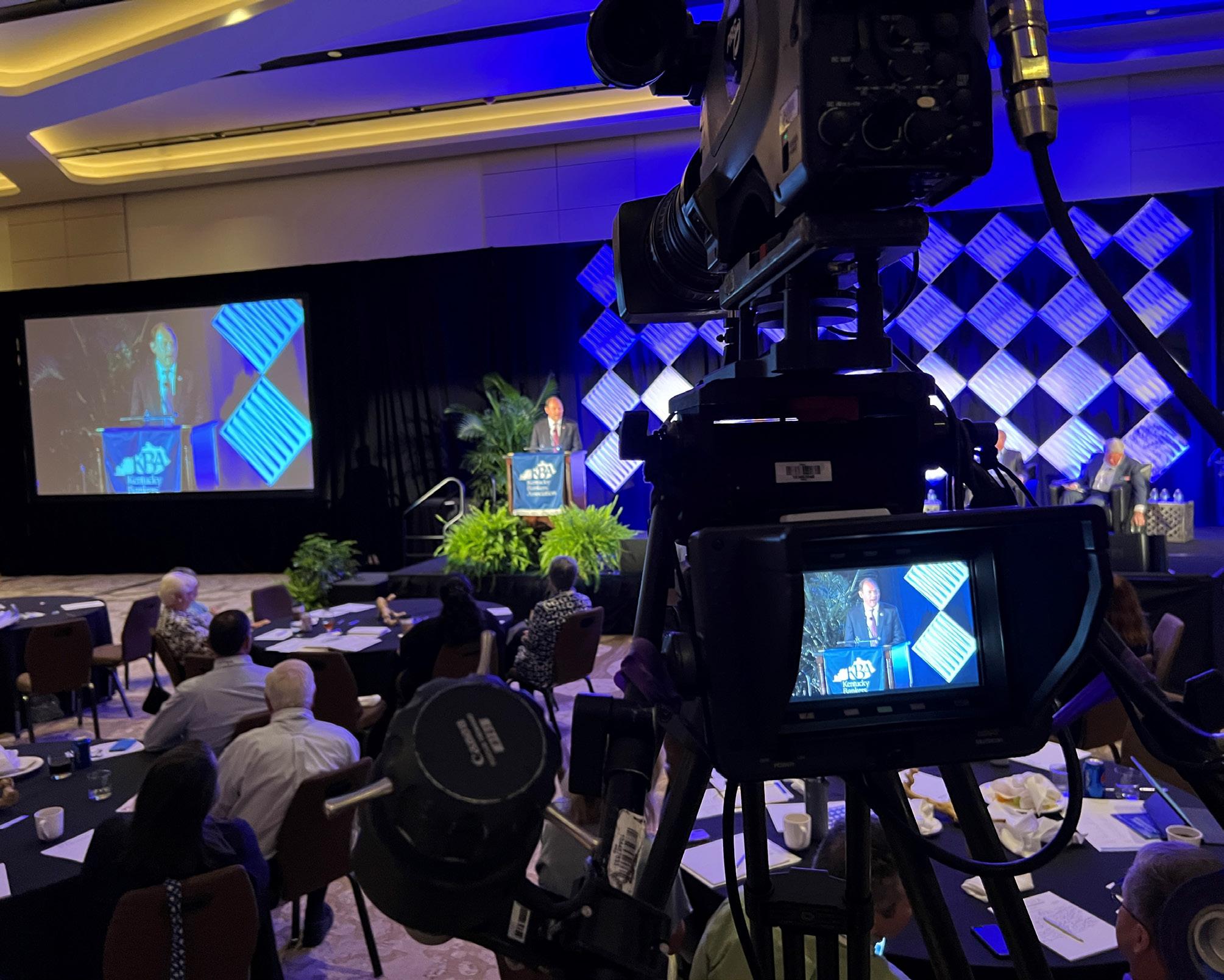
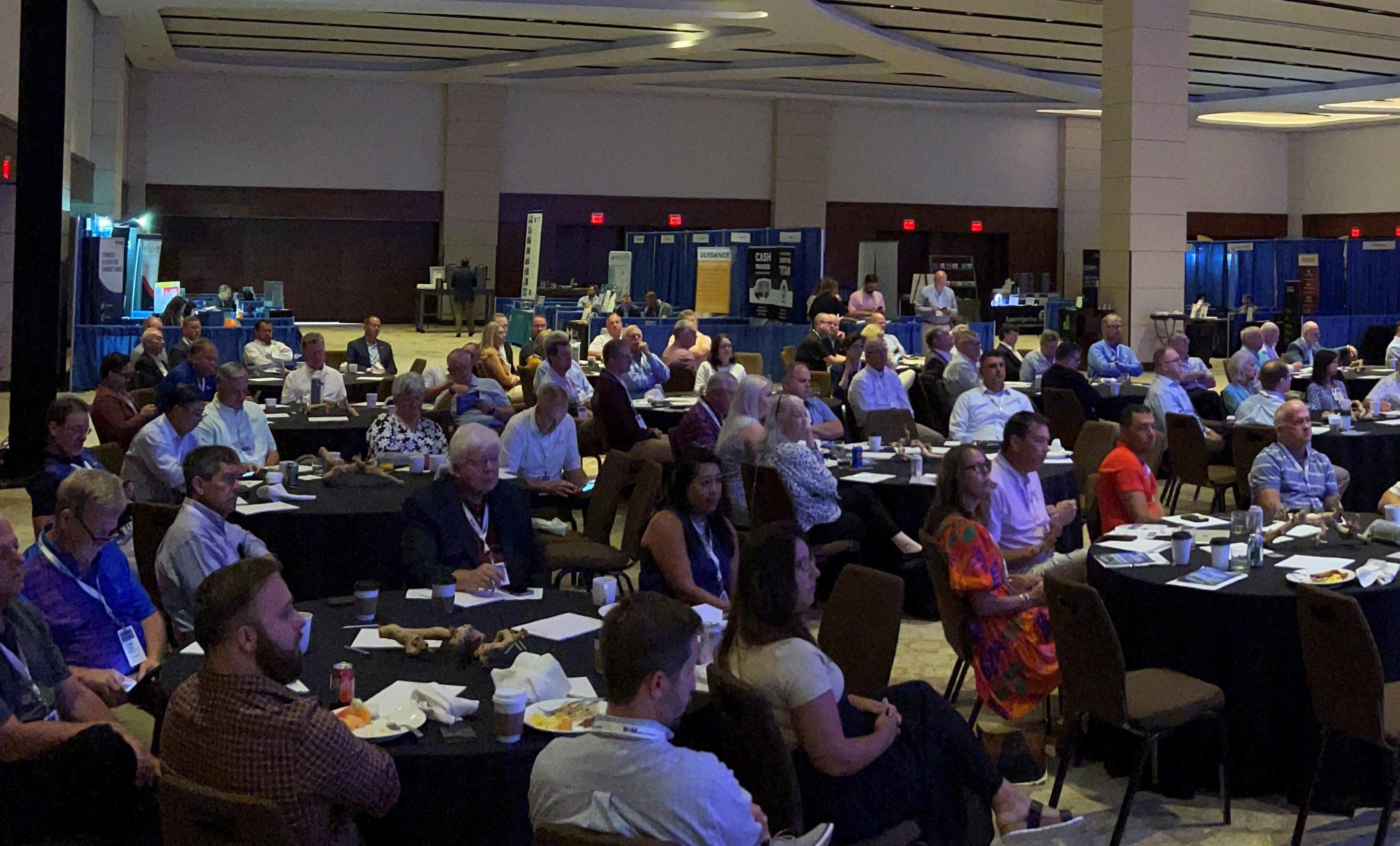


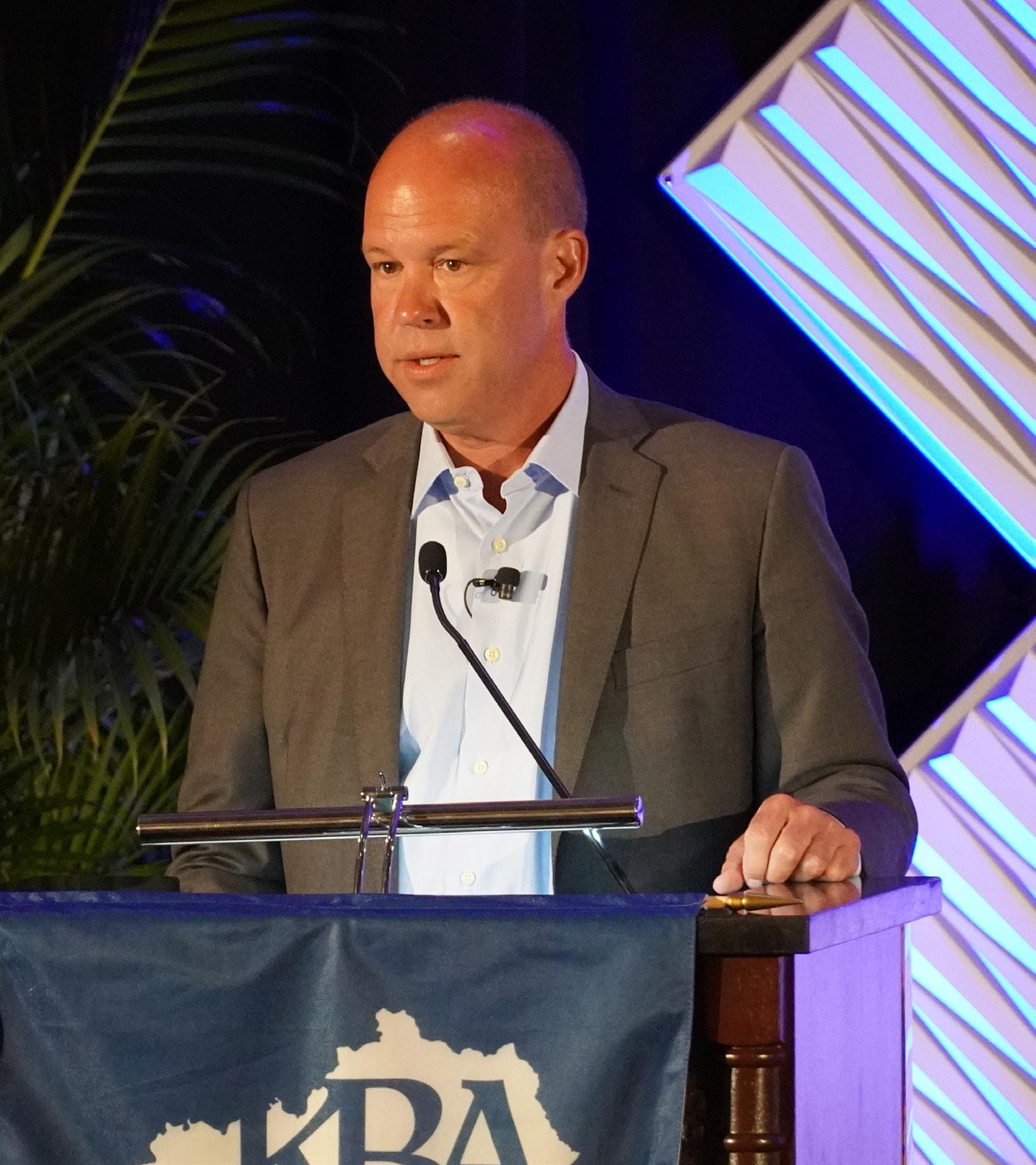


 SEPTEMBER 17-20, 2022 Marco Island, Florida
James A. Hillebrand 2021-2022 Chairman, KBA Chairman & CEO, Stock Yards Bank & Trust
Andy Barr Representative for Kentucky’s District
SEPTEMBER 17-20, 2022 Marco Island, Florida
James A. Hillebrand 2021-2022 Chairman, KBA Chairman & CEO, Stock Yards Bank & Trust
Andy Barr Representative for Kentucky’s District
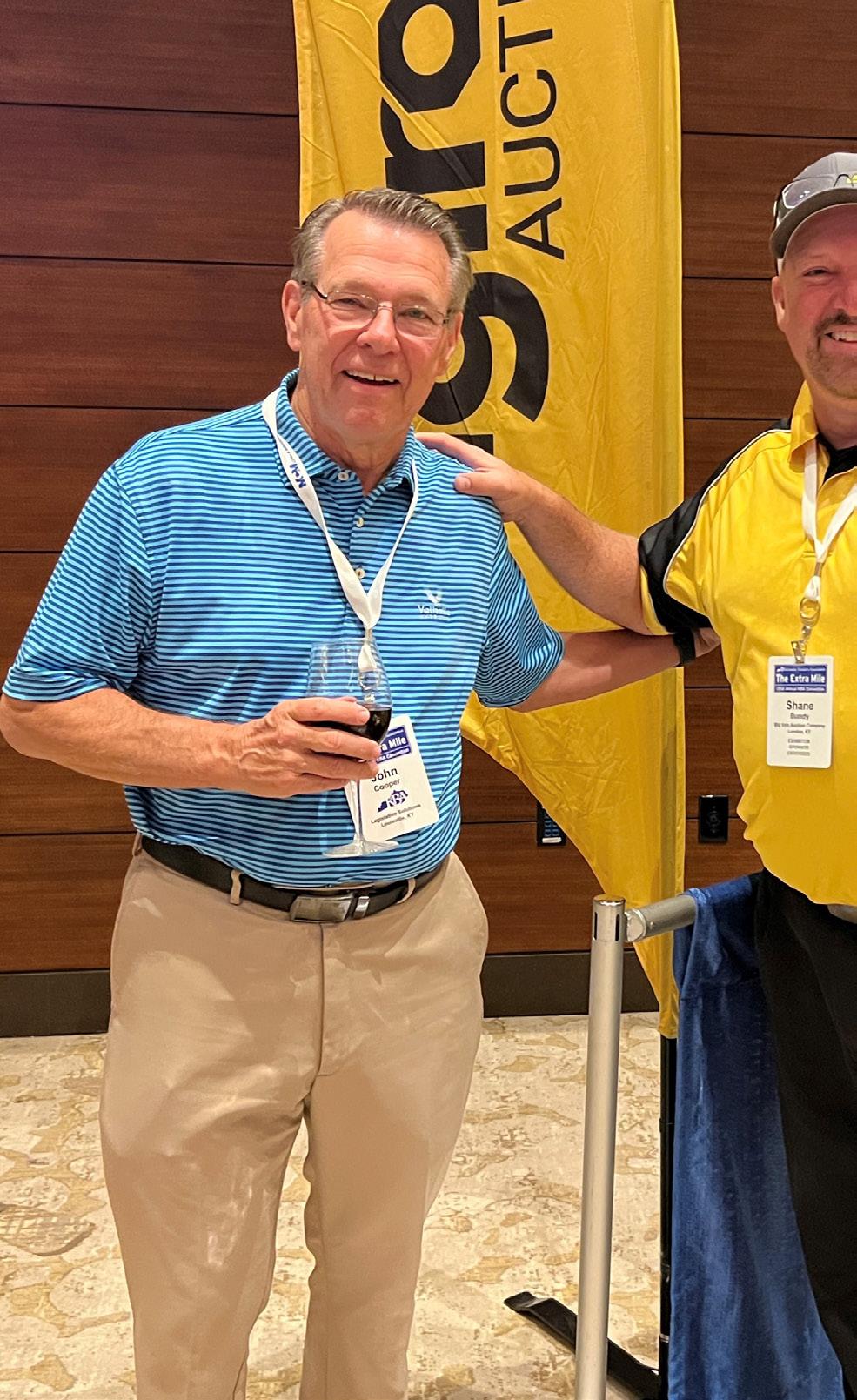
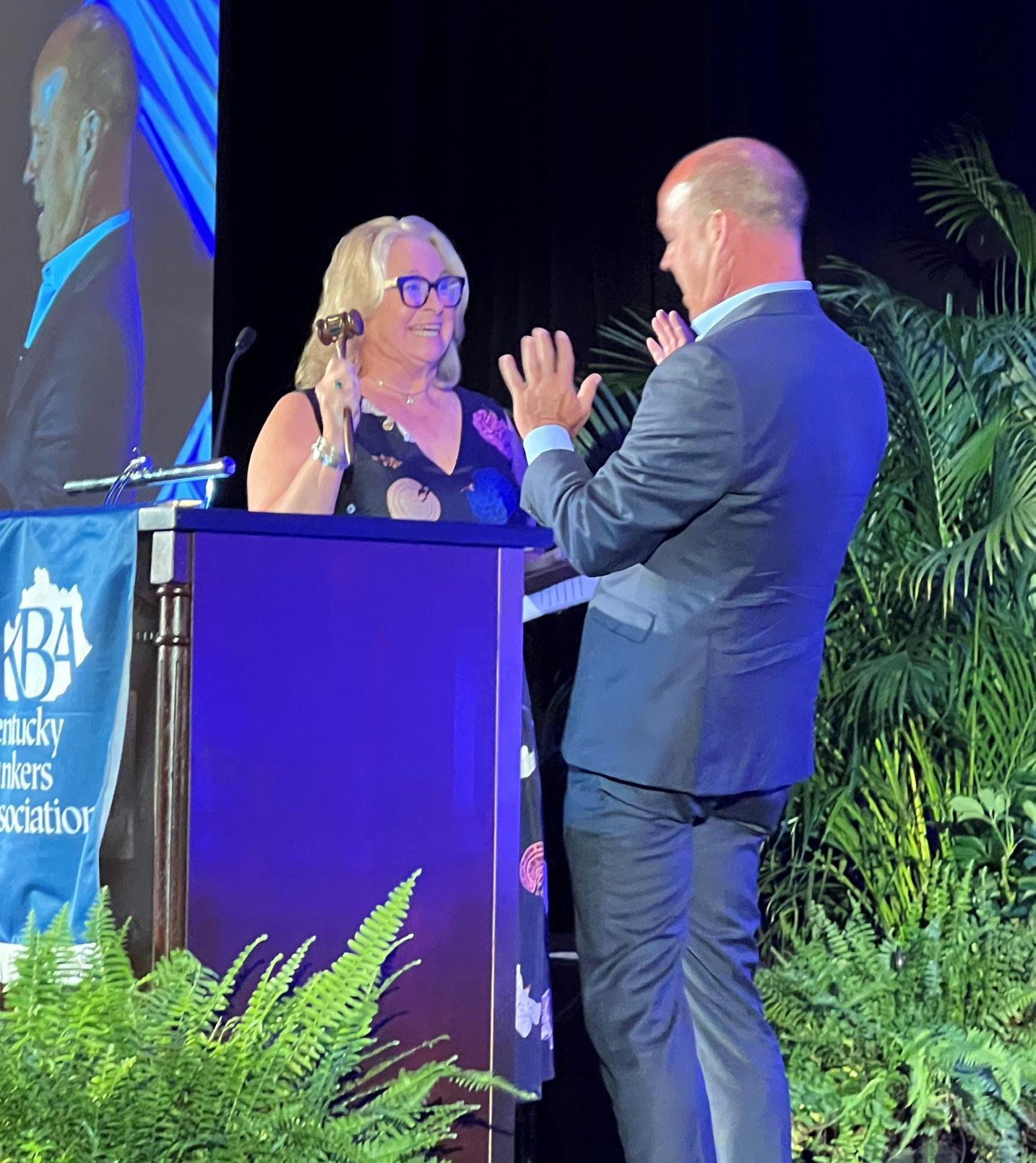

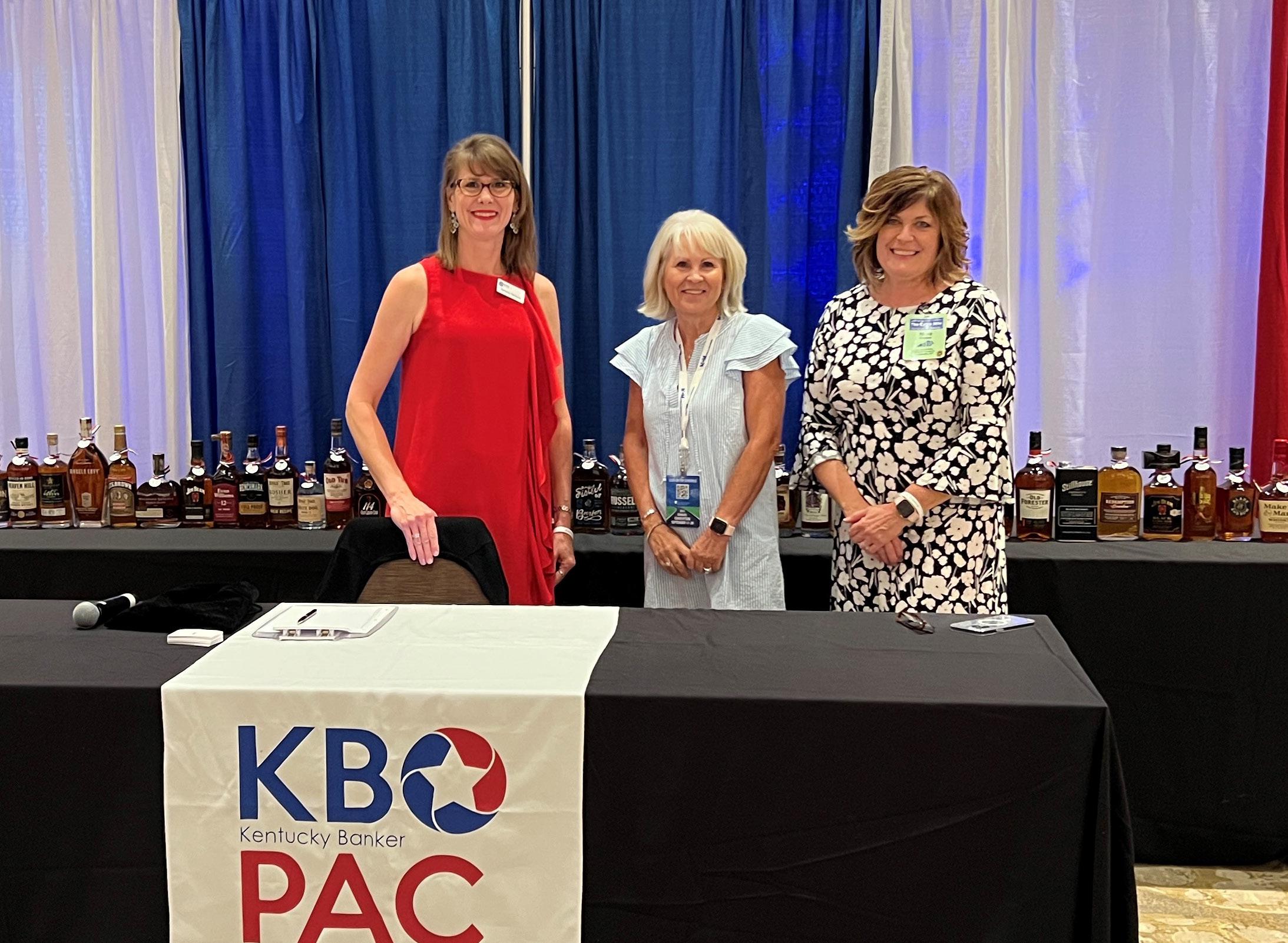
 Tammy Nichols, Lanie Gardner and Nina Gottes at the KBPAC Bourbon Pull Fundraiser registration table. 50 bottles were up for grabs in this crowd favorite event
Tammy Nichols, Lanie Gardner and Nina Gottes at the KBPAC Bourbon Pull Fundraiser registration table. 50 bottles were up for grabs in this crowd favorite event

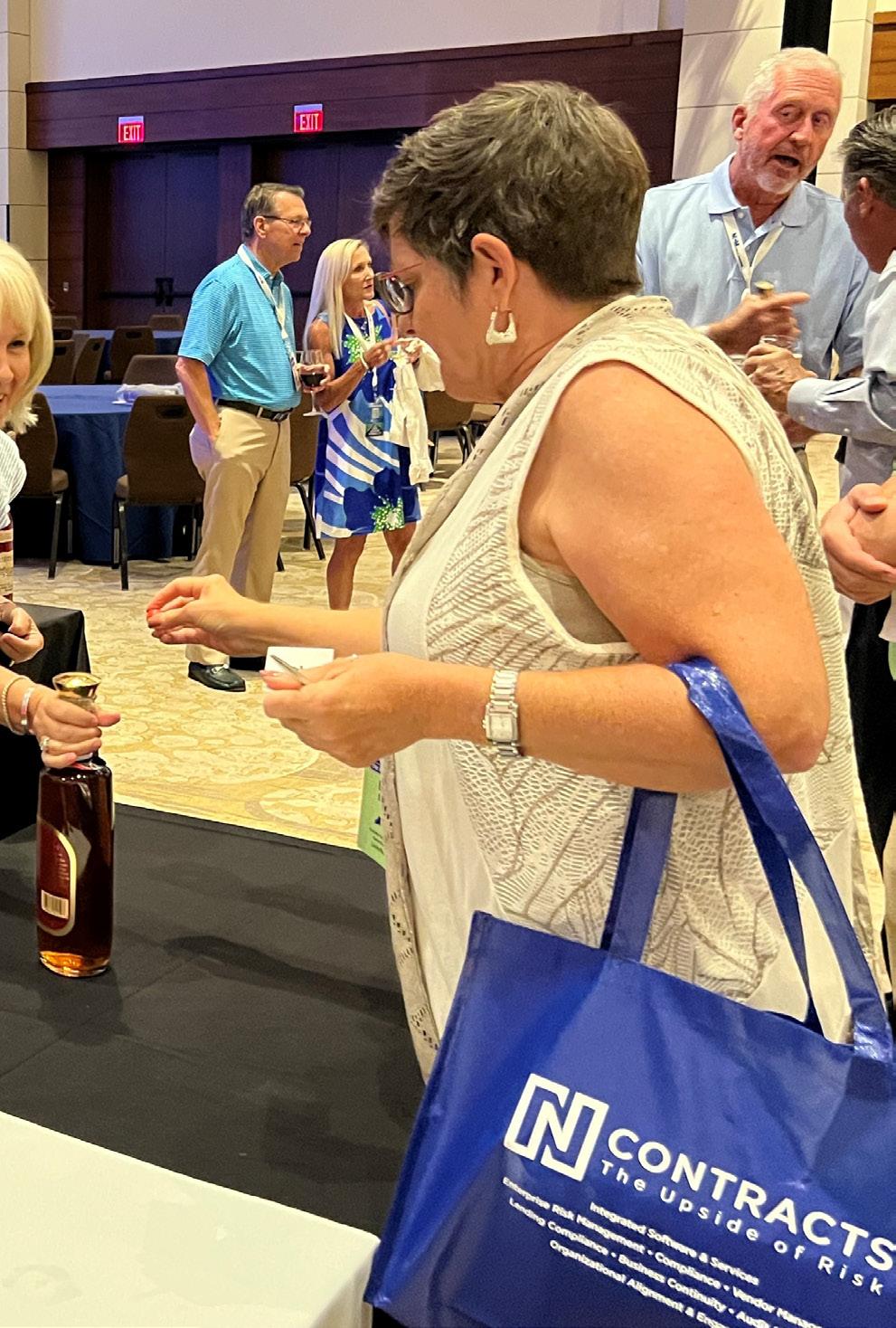
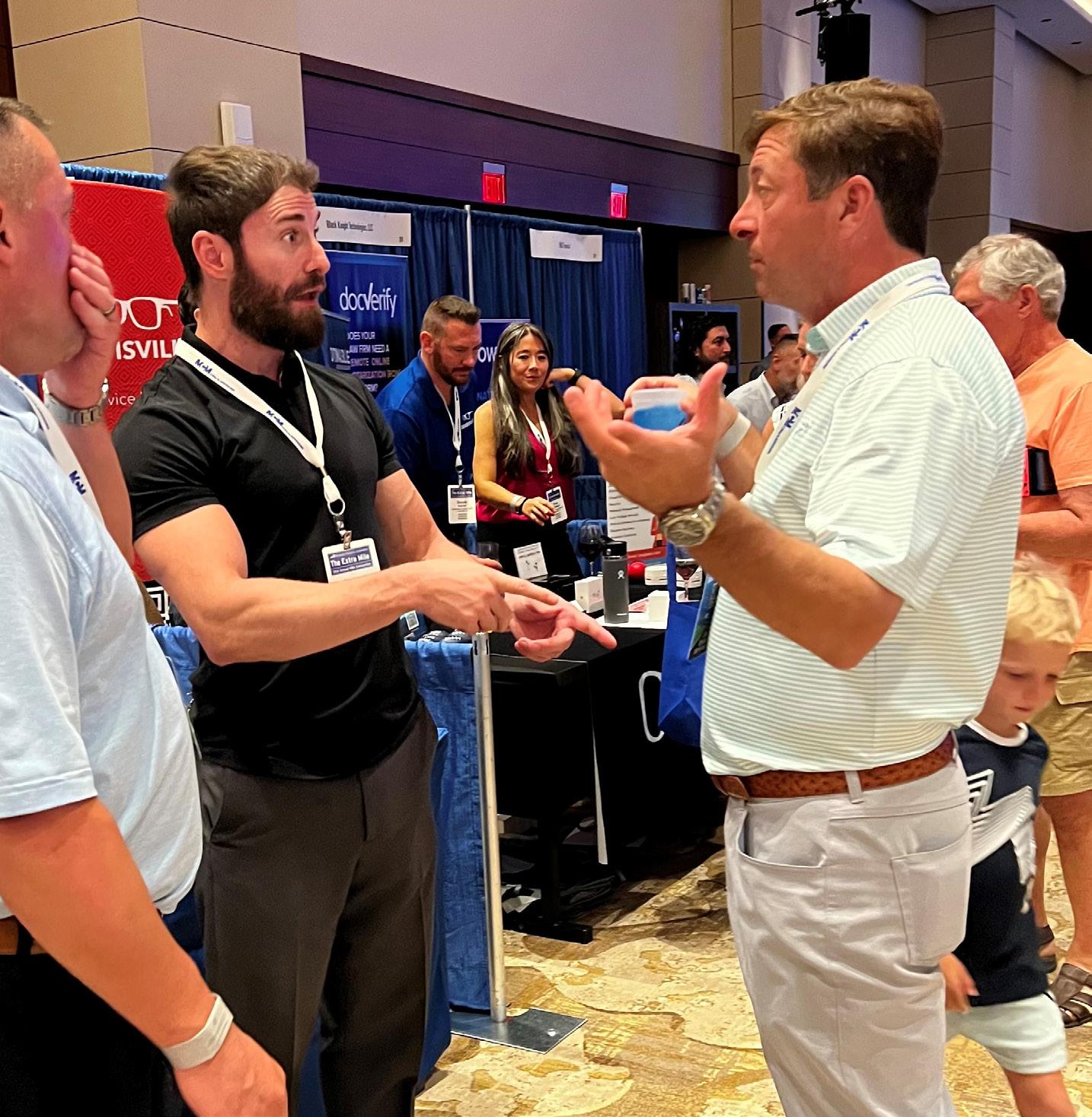
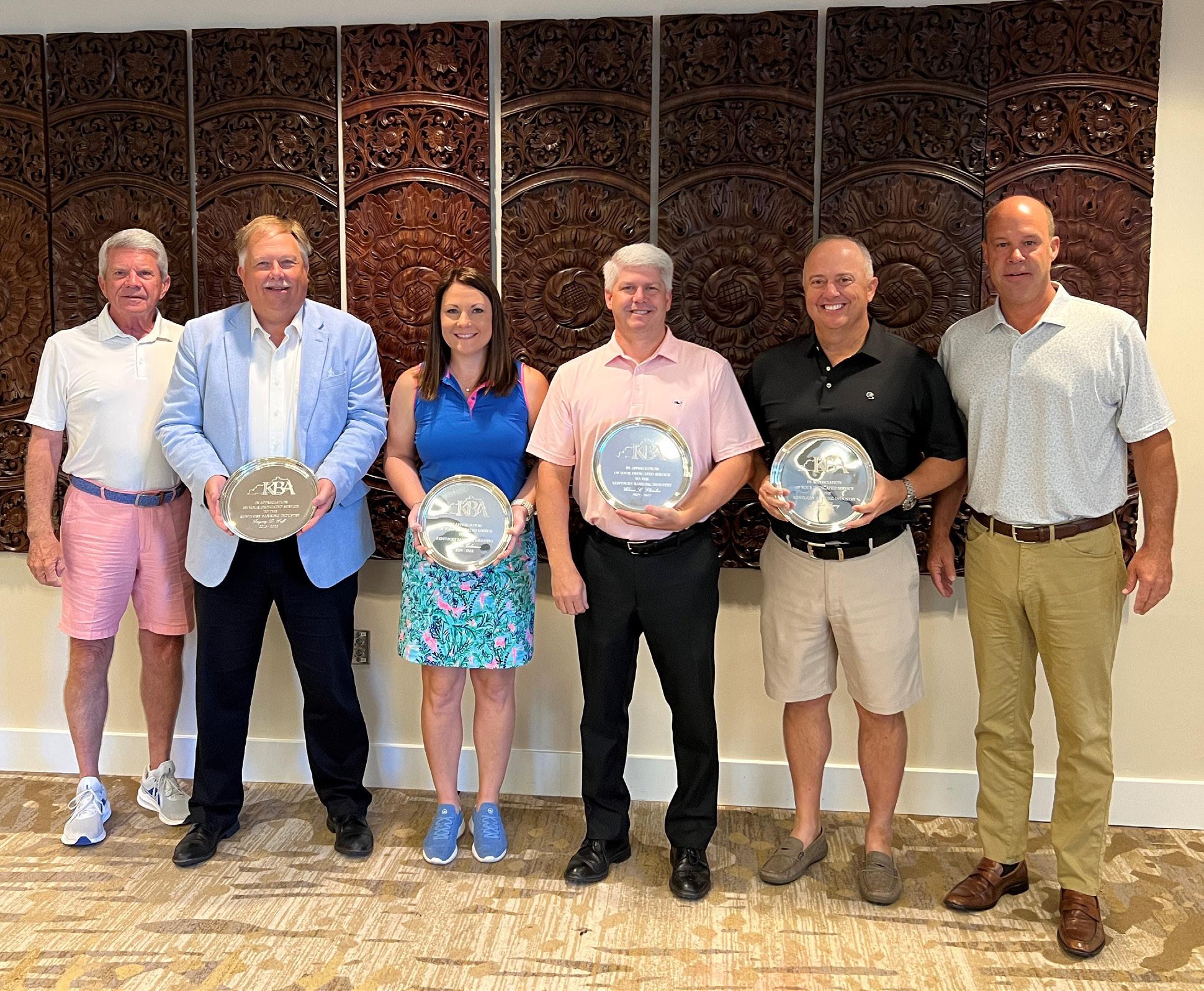

 KBA Endorsed Convention’s Exhibit Hall
James Goatley, with KBA Endorsed Vendor Louisville/Lexing ton Geek, and Tyler Cook, with KBA Endorsed Vendor Banc Card of America, talk at the 2022 Convention’s Exhibit Hall
gives a winning to Debra Stamper
Thank you outgoing KBA Board members: Greg Goff, Michelle Coleman, Elmer Whitaker, Wade Berry; also pictured Ballard Cassady (far left) and Ja Hillebrand (far right).
KBA Endorsed Convention’s Exhibit Hall
James Goatley, with KBA Endorsed Vendor Louisville/Lexing ton Geek, and Tyler Cook, with KBA Endorsed Vendor Banc Card of America, talk at the 2022 Convention’s Exhibit Hall
gives a winning to Debra Stamper
Thank you outgoing KBA Board members: Greg Goff, Michelle Coleman, Elmer Whitaker, Wade Berry; also pictured Ballard Cassady (far left) and Ja Hillebrand (far right).
The Federal Home Loan Bank of Cincinnati’s Board of Directors announced a $3 million contribution to benefit affordable housing initiatives. This allocation is in addition to the FHLB’s required 10 percent of net earnings set-aside to fund the organization’s Affordable Housing Program (AHP).
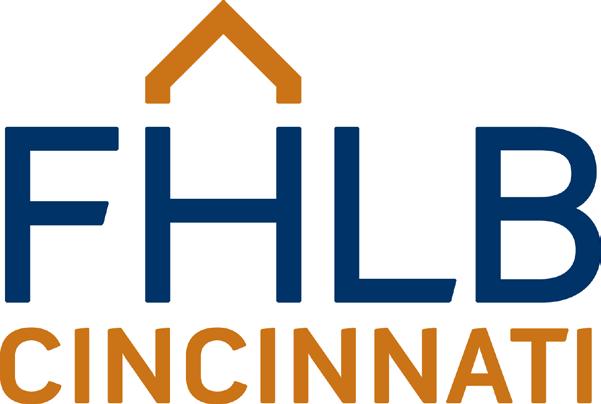
“I’m grateful that the FHLB Board of Directors will contribute an additional $3 million to increase access to affordable housing throughout the areas we serve. By providing these funds to bolster the long standing success of FHLB Cincinnati’s Affordable Housing Pro gram, we’ll be able to put this voluntary contribution to work in the communities where it is needed most,” said Andrew S. Howell, President and CEO, FHLB Cincinnati.
Donated funds will be distributed with the FHLB’s 2022 Affordable Housing Program general grant fund and recipients of awards will be announced on November 17.
Since the inception of the AHP in 1990, the FHLB has awarded over $829 million in subsidies towards the creation of more than 103,000 units of affordable housing.

Finding the right path to improve inclusive banking efforts while also supporting fair lending and Community Reinvestment Act (CRA) risk management is challenging for many financial ser vices organizations. Rather than viewing the process as an ex tended series of hurdles to overcome, though, organizations can view inclusive banking as a proactive, strategic opportunity to boost performance while also increasing corporate and social re sponsibility expectations.
Incorporating an intentional, focused inclusive banking plan re quires a strategic focus on the internal and external factors that help make products and services more accessible and affordable to all potential individuals and businesses.
Here are five areas your organization can focus on to improve and expand its inclusive banking efforts:
1. Break down barriers among internal collaborators
More consistent and frequent collaboration among involved de partments and stakeholders can help strengthen inclusivity efforts. For example, is the fair lending team communicating regularly –or at all – with the CRA and product development teams? Are those teams communicating regularly with the board of directors or C-suite? If they’re not, then your organization might be miss ing out on a steady flow of information that fosters new insights and influences improved or future strategies.
2. Identify potential relationships that can help improve inclusive banking efforts
Many geographies have organizations that are already devoting time and resources to support underserved communities and im prove performance in majority-minority census tracts (MMCTs). Identifying opportunities to form partnerships, sponsorships, and collaborations can benefit all parties. Organizations that can help might include:
• Minority and women-focused chambers of commerce and business resource groups
• Organizations focused on supporting specific communities or under-resourced individuals, such as housing authorities and community action groups
• Fintechs offering a product or service that serves under banked communities
3. Regularly review products and services for accessibility
Financial services organizations might have physical branch lo cations available, but do they also have processes in place that allow everyone fair and equal access to all products and services in that community?
Organizations should study offerings and distribution channels to determine how they might be adjusted and expanded to be more inclusive. For example, if the point of entry on a home equity loan isn’t attainable for potential customers at all locations equal ly across the communities that an organization serves, changing the requirements might be warranted.
4. Align policies and procedures to meet continually changing regulations
Financial services organizations can build comprehensive inter nal strategies that incorporate new laws, regulations, and initia tives to give employees up-to-date policies and training.
In recent years, for example, the Federal Housing Administration and Department of Housing and Urban Development added pro tections for sexual orientation and gender identification related to housing discrimination. Organizations need to communicate that information to make sure their customers do not face discrimina tion based on sexual orientation or gender identity.
When financial services organizations communicate with the communities they serve, they can receive more insights, build more trust, and recognize new opportunities.
Communication can take many forms, from focus groups and marketing efforts to participation in community events and business functions. These ways of connecting with communities help organizations learn about surrounding demographics and customer needs. For example, organizations can include employees that speak different languages to support the needs of diverse customer bases.
The importance of representation and accessibility is also critical. Banks can be intimidating for many people, even more so for those who don’t see themselves represented within the organization’s operations. How community members are treated and their ability to conduct business in a variety of languages can affect whether they are able to see themselves reflected in their financial services organizations.
Crowe can help you identify opportunities through inclusive banking: Financial services organizations can take advantage of multiple avenues to implement effective inclusive banking strategies. These strategies are designed to support business growth and man agement of fair and responsible banking laws and regulations. However, it’s important to realize that there’s no one-size-fits-all approach. Social responsibility plans must align to the organizational strategy and composition of a bank’s customer base, with different approaches tailored for different segments. Crowe specialists combine deep industry experience and regulatory knowledge to help organizations accurately assess and build proactive plans that help serve all customers. Contact Selina Parrish at the KBA for more information on Crowe: sparrish@kybanks.com

The internet is a network of billions of computers, millions of servers and numerous other electronic devices. Once online, internet users can communicate with each other, share data and applications, complete financial transactions, view and interact with websites and buy and sell goods and services.
The metaverse doesn’t compete with the internet – it simply builds on it. In the metaverse, users cross into a virtual world that mimics aspects of the physical world using such technologies as VR, augmented real ity (AR), artificial intelligence (AI), social media and digital currency. The internet is something that people “browse” or “use.” But, to a de gree, people can “live” in the metaverse.
There are currently no metaverse-specific laws. But, as with any new development, there is already a network of existing laws that can apply.
In some ways, it already has—and successfully. Fortnite has been a leader in virtual transactions. Players, for example, use real money to buy V-Bucks, which they then use within the game to buy outfits, tools and other accessories for their avatars. Epic Games, creator of Fortnite, generated gross revenue of $5.8 billion in 2021.
The metaverse will also unlock new opportunities for buyers and sell ers to connect in new ways. Some companies already use AR and VR to enable customers to try on or try out their merchandise. Ferrari, for example, showcases its luxury automobiles in AR to better permit exploring models’ various features, while Apple employs AR to assist customers in familiarizing themselves with iPhones and Macs.

The metaverse is sure to continue developing and evolving. As it does, the impact on businesses will grow in importance. Expect firms to in creasingly leverage the metaverse for training purposes (yes, they’ve already begun). Orientation, continuing education, simulations, enter tainment and other activities are sure to follow. Just as the Internet changed the way most everyone works so, too, does the metaverse pack the same potential.
Want more information about Louisville/Lexington Geek? Contact Selina Parrish at the KBA, and/or scan the QR code at the bottom right. Selina’s email: sparrish@kybanks.com
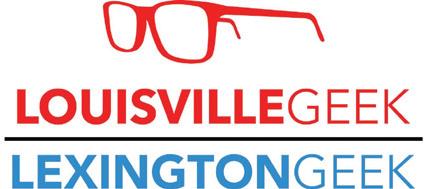


When rates were at record lows for long periods of time, the true value of low-cost funding may have faded into the background; however, low-cost core deposits continue to be the driver of long-term franchise value. Now, with rates continuing to rise – the one-year treasury exceeded 4% in September 2022 – the importance of low-cost funding is once again at the forefront.
The chart (next page at bottom) is for a financial institution with strong low- and no-cost funding. In record low-rate environ ments, its cost-of-funds advantage over its peers was relatively small at 20-30bp. When rates started to rise from 2017 – 2019, it tripled to 60bp. For a $1 billion institution, that represents a $6 million increase to the bottom line. The current rising rate environment will lead to similar increases in profit. In addition, deposit growth has stagnated in Q2 of 2022. On the macro level, FDIC insured deposits were down for the first time in a long time, and they were down significantly at 1.85% from the prior quarter. On the micro level, our data for consumer and business checking account deposit balances shows balances are down 3% and 7%, respectively, from the beginning of 2022. Even more importantly, the entire balance decline happened in May and June 2022, a trend we anticipate will continue.
Large institutions are aware of the value created by low-cost de posits, and they have the budgets to target core relationships that drive these benefits. For example, Chase is back to its $600 offer for opening a checking and a savings account. BMO Harris pays up to $500, and Citi has an offer of up to $2,000 for relationships with extremely high balances.
In addition to the cost of the offer, these largest banks spend a significant amount of marketing dollars to gain new core rela tionships and the benefits that come with them. When a financial institution does not commit to an always-on marketing strategy,
it must provide above market offers to “buy” new relationships.
Community-based financial institutions (FIs) cannot compete by following a similar strategy. Unlike their large competitors, community-based FIs do not have the budgets for acquisition incentives of $500+ or the expansive budgets associated with marketing to acquire these relationships.
Compared to community-based FIs, large banks generally have more products and services as well as marketing teams who dwarf their smaller competitors. Given this reality, what does a community-based FI need to do to thrive?
To grow low-cost deposits, it is essential you follow a disciplined approach:
Step One – Your Institution Must Have a Sales and Ser vice Culture. Good products are the foundation of a sales and service culture. You cannot ask your teams to sell, or consumers to buy, inferior products. If you want to know if your institution has good products, ask your customer- fac ing employees; they can tell you how consumers respond. Equally important is ensuring your team members are welltrained, understand and believe in your products and consis tently execute your service expectations.
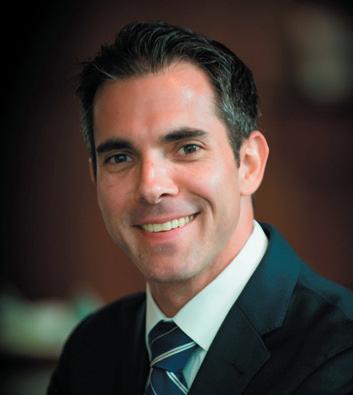

Step Two – Your Institution Must Be Strategic. Large institu tions have the staffing and marketing budgets that allow them to frequently change offers, products marketed and/or desired pros pects. For community-based FIs to compete, they must make da ta-driven, always-on marketing part of their core growth strategy. Your always-on marketing strategy supported by your sales and service culture will drive tangible results even when large banks are in periods of very high offers.
Step Three – Your Institution Must Be Aligned. Your FI’s train ing and execution at the branch and through online channels must be aligned with your strategic marketing. Aligning marketing and execution is what reduces the acquisition costs for new core re lationships. Without this alignment, your FI is left trying to com pete on the offer alone, making it expensive to match those large bank offers previously mentioned.
Step Four – Measure, Inspect and Reward! Any strategic initia tive needs to be measured. Your core relationship growth strategy should have periodic – quarterly at least – goals. In addition, de termine benchmarks to evaluate success. Inspect what you expect in order to ensure your sales and service standards are being con sistently executed. Reward success! When your team members are fully aware of where they stand compared to their goals, it’s possible to evaluate results and reward successes.
Growing core relationships in order to grow low-cost deposits should be of primary importance in any rate environment; however, it is par amount in the current rising rate environment. Ultimately, out-per forming your peers by 60bp will be welcomed by your board and celebrated by your management team. When you strategically align your culture, products, and people, competing for core relationships becomes easier and the $500+ offers from large banks become less effective. David will beat Goliath!
Achim Griesel is president and Dr. Sean Payant is chief strategy of ficer at Haberfeld, a data-driven consulting firm specializing in core relationships and profitability growth for community financial insti tutions. Achim can be reached at 402.323.3793 or achim@haberfeld. com. Sean can be reached at 402.323.3614 or sean@haberfeld.com.



As cyberattacks continue to plague businesses worldwide, Matrix Integration, a strategic IT infrastructure partner for more than 1,000 businesses and schools in Indiana, Kentucky and beyond, has identified three major trends that can not only help prevent breaches, but can save businesses millions of dollars.
“From industrial manufacturers to smaller service-based businesses, we see some common threads that could help businesses manage their cybersecurity,” said Tim Pritchett, security expert and engineer operations manager at Matrix Integration. “For this year’s National Cybersecurity Month, it’s crucial to remember that if you or your company haven’t been hacked yet, it’s only a matter of time before you will be. You need to be ready.”
Being aware of these three major cybersecurity trends and what you can do about it is the first step to help business leaders harden their defenses against cyberattacks.
1. Holiday Hacking. Pritchett and the Matrix team see an uptick in hacking attempts during holidays and long weekends, a trend that’s been confirmed by the FBI and the Cybersecurity and Infrastructure Security Agency (CISA).1 “During the holidays people’s guards are down,” said Pritchett. “A simple ‘out-of-office’ auto-reply can alert bad actors that it’s a good time to break into a system.”
2. Insurance Interruptions. Cybersecurity insurance is a necessary business expense today, but is becoming more difficult to obtain. Insurance issuers want proof that their clients have adequate cy bersecurity in place, so Pritchett and his team often see businesses scrambling to get protections in place to meet insurance company deadlines. “Make sure you know when your policies are coming up for review,” said Pritchett. “They will audit you, and you need to be ahead of the curve to avoid being dropped from your insurance carrier.”
3. Passé Password Control. Most computer users know that simple passwords are easily hacked. But more than passwords, companies need sophisticated access and authentication technology to keep the most sensitive information safe. “Role-based access control and multifactor identification and authentication needs to be standard to
make sure only the right people are accessing the right information in your network,” said Pritchett.

Depending on the type and size of business, companies can take a number of steps to better secure themselves against cyberattacks. Smaller businesses may want to outsource cybersecurity altogeth er, an arrangement that can provide 24-7 protection at a reasonable monthly cost. Other businesses may need a more sophisticated re view and series of upgrades. But all businesses still need to imple ment employee outreach and remediation plans. Cybercriminals still rely on the human element to steal credentials and capture data. Ac cording to the 2022 Verizon Data Breach Investigations Report,2 82 percent of breaches in 2021 involved employees falling for phishing scams through email or social media.
Regardless of what companies do, continuing to strengthen defenses against hackers is always a good policy. “These are the basics. By implementing them, you will be better off than you were yesterday,” continued Pritchett.
For more information on cybersecurity and solutions including MiProtection, people can visit matrixintegration.com, or contact the KBA’s Selina Parrish sparrish@kybanks.com
Matrix Integration is a strategic IT solutions and managed services provider that has been in business for more than 40 years. With cli ents regionally and offices in Indiana and Kentucky,


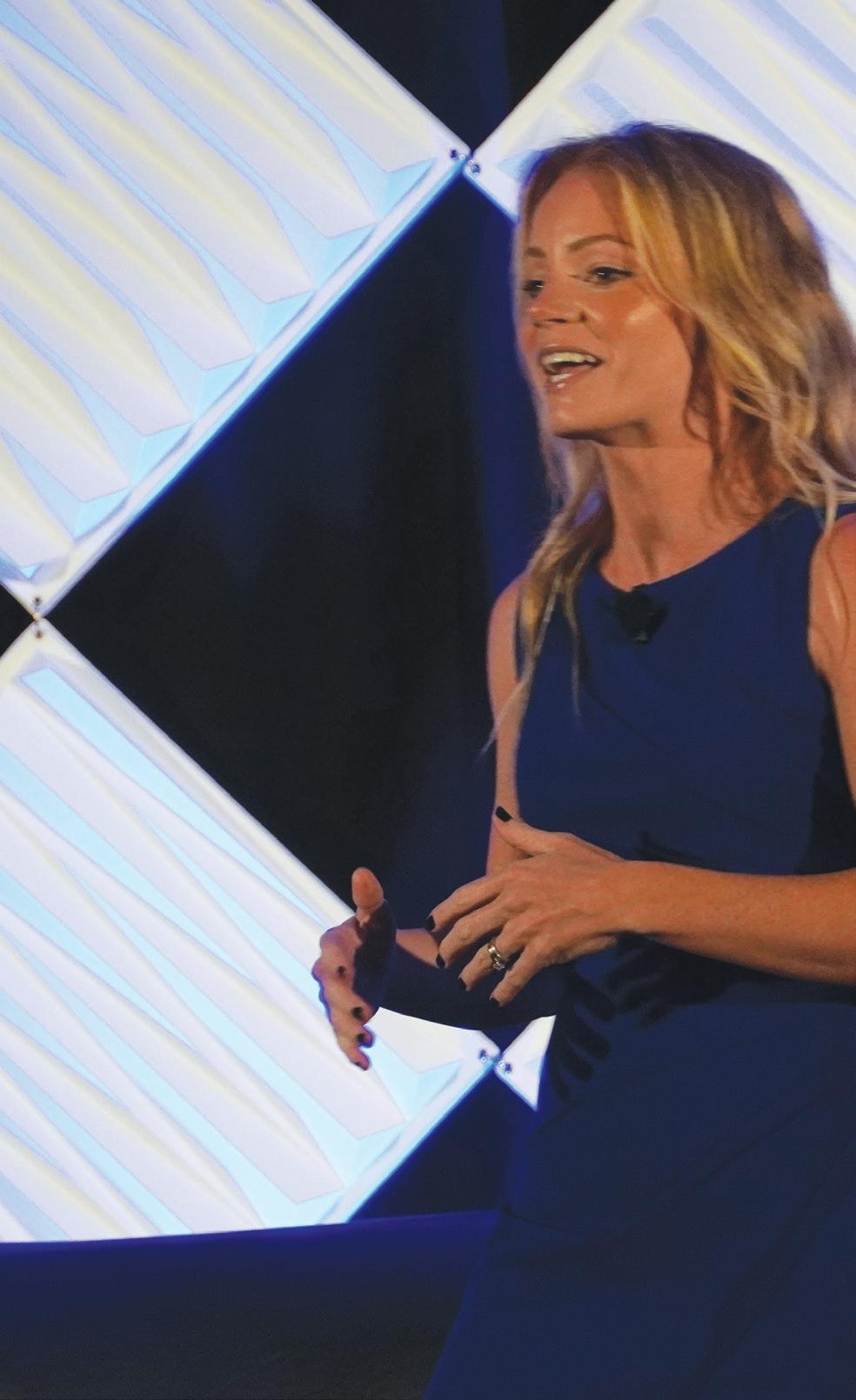

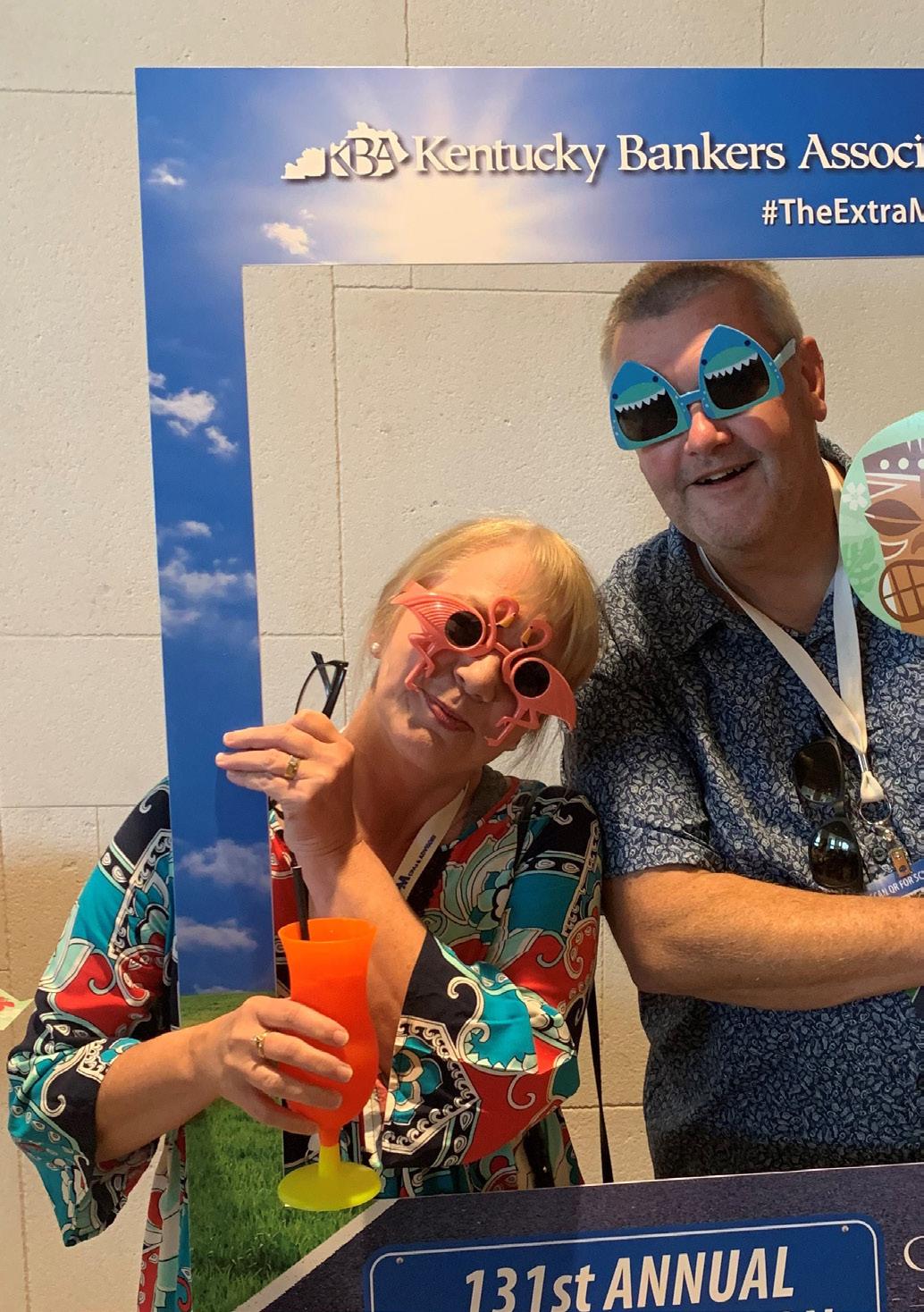

 Milton Bartley, Head of Banking Solutions Co-Founder, President & CEO, ImageQuest
Tornadoes, Turnover, & Today’s Employees: What Bank Leader Needs to Know & Do to Elevate Team Alyson Van Hooser, Van Hooser Associates
Milton Bartley, Head of Banking Solutions Co-Founder, President & CEO, ImageQuest
Tornadoes, Turnover, & Today’s Employees: What Bank Leader Needs to Know & Do to Elevate Team Alyson Van Hooser, Van Hooser Associates

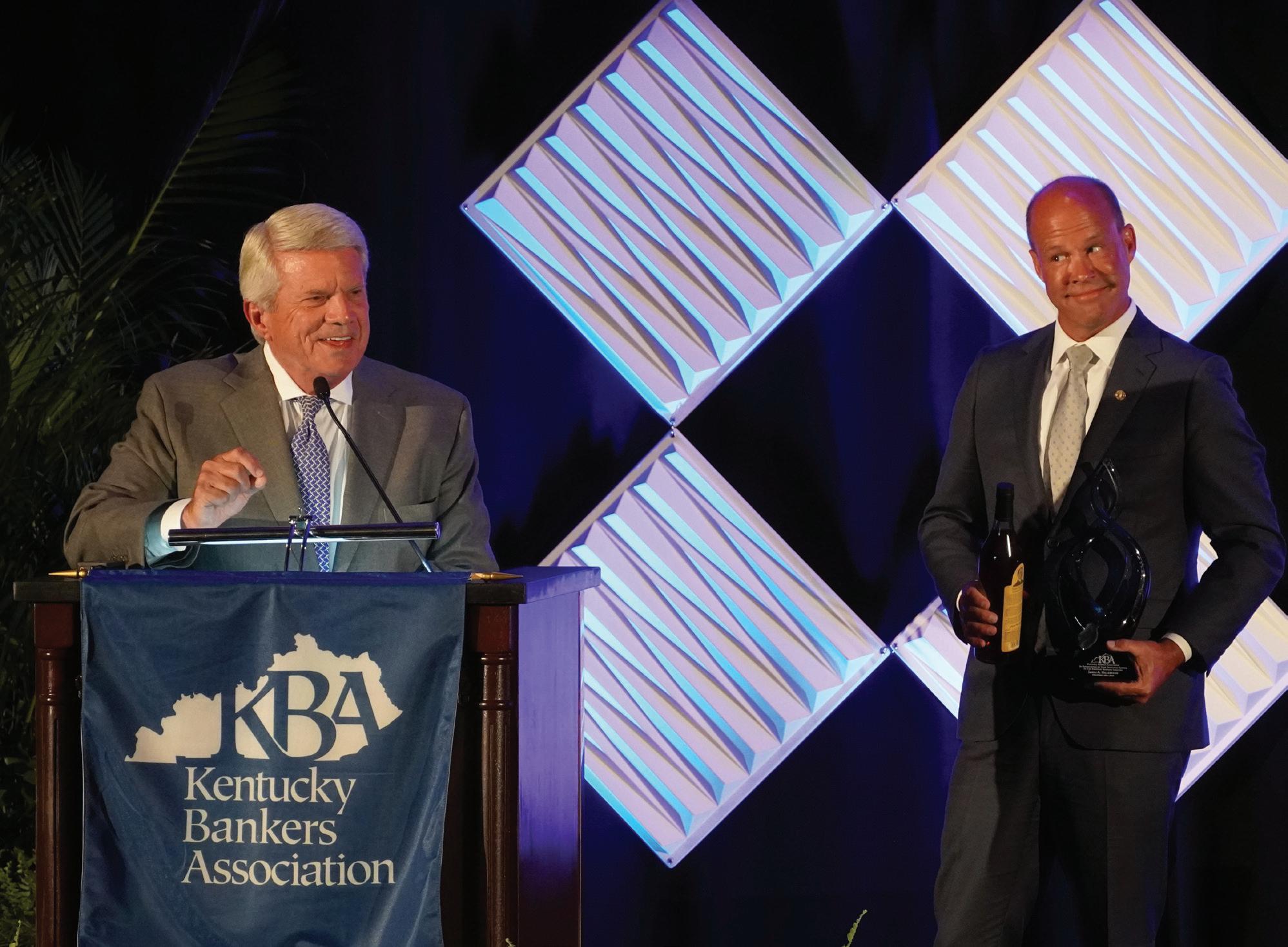


 KBA President & CEO, Ballard Cassady, thanks outgoing KBA 20212022 Chairman, Ja Hillebrand, Chairman & CEO, Stock Yards Bank & Trust Co., for his year of service as Chairman of the KBA.
What Every Team Success
Convention emcee, John T. McGarvey, Esq. Morgan & Pottinger P.S.C. and 2022 Economic Outlook presenter, Dr. Lindsey Piegza, Chief Economist, with Stifel Financial
Bank, take a Duncan-Williams
KBA President & CEO, Ballard Cassady, thanks outgoing KBA 20212022 Chairman, Ja Hillebrand, Chairman & CEO, Stock Yards Bank & Trust Co., for his year of service as Chairman of the KBA.
What Every Team Success
Convention emcee, John T. McGarvey, Esq. Morgan & Pottinger P.S.C. and 2022 Economic Outlook presenter, Dr. Lindsey Piegza, Chief Economist, with Stifel Financial
Bank, take a Duncan-Williams
